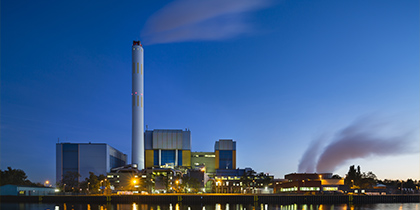The Clean Industrial Deal, presented in February 2025, sets new requirements for how industrial manufacturing companies, logistics chains and waste handlers deal with waste, energy and design. But what does it mean in concrete terms? And how can you not only meet the new requirements, but also benefit from them?
In this blog you will read what the Clean Industrial Deal means, why it was introduced and how you as a company can respond to the changes.
The Clean Industrial Deal is the successor to the European Green Deal. With this plan, the European Commission wants to make Europe's industry future-proof: less CO2 emissions, less loss of raw materials and more reuse of materials
Clean Industrial Deal and your company: what does it mean in concrete terms?
Is your organization active in industrial production, logistics or waste processing? If so, you may be affected by the Clean Industrial Deal. Below you can read what to expect.
- Stricter regulations
Companies will face stricter requirements regarding emissions, waste processing and product design. For example, waste streams must now be better separated at source and correctly coded according to the European Waste List(Eural list).
A key issue here is the reusability of residual streams. Where waste was previously automatically disposed of as residual waste, companies must now demonstrate whether (and how) materials can be reused - for example, through recycling, refurbishing or reuse in their own production.
This applies in particular to industrial production companies, logistics chains and waste processors. In many cases, this requires working with processors or chain partners who can assess whether a stream still has value. Think of metal residues, plastics or packaging materials that - if properly separated - can be reused as raw materials.
The goal: less incineration or landfill, and more value retained in the chain.
- Reporting requirements
The CSRD (Corporate Sustainability Reporting Directive) requires larger companies to report on their impact on people and the environment. The Clean Industrial Deal aligns with this and further tightens data collection and transparency. Companies must not only provide insight into what they do, but also demonstrate with concrete measurable data how they manage their waste streams, reuse materials and design circularly. This requires detailed monitoring, consistent reporting and a clear link between policy and practice.
Case study:
A manufacturer of industrial machinery previously only had to report on CO2 emissions. With the combination of the CSRD and the Clean Industrial Deal, the company must now also demonstrate how waste streams are processed and to what extent the design is circular. These additional requirements will apply incrementally starting in reporting year 2025.
- Circular design
Products must not only be developed using as little raw material and energy as possible, but also be easy to disassemble, repair or recycle. This requires adjustments in the design and development process. An opportunity for innovation - but also a necessity. In the context of the Ecodesign for Sustainable Products Regulation(ESPR), circular design criteria are increasingly being legislated. Think of obligations around material selection, reparability and lifespan, which companies must be able to substantiate with measurable product information (e.g. via Digital Product Passports).
- Financial incentives
The transition to circular production often requires substantial investments in new technology, process modifications or chain cooperation. Companies run into challenges here such as high investment costs, longer payback periods and uncertainty about the returns from reuse or recycling.
To lower these barriers, more and more subsidies, tax breaks and financing options are becoming available. Consider support for investments in separation technology, reuse of materials or digital monitoring of waste streams.
Why the Clean Industrial Deal is important
European industry is responsible for a large proportion of emissions and resource use. At the same time, there are opportunities: those who deal smartly with waste streams and design circularly can save costs and tap into new markets. The Clean Industrial Deal wants to accelerate that change.
Specifically, the EU wants to:
- Reduce industrial emissions by at least 55% in 2030 compared to 1990.
- Become less dependent on scarce raw materials from outside Europe.
- Stimulate innovation around recycling and waste management.
For your company, this means that more is expected than just reporting: you must also show how you are actively working to improve your impact.
Related EU legislation: PPWR, ESPR, ETS
The Clean Industrial Deal does not stand alone. Several EU laws reinforce each other and are part of a broader European strategy.
The Green Deal forms the basis: this is the overarching plan by which the EU aims to be climate neutral by 2050. The Fit for 55 package translates that ambition into concrete targets for 2030, such as 55% less CO₂ emissions. The Clean Industrial Deal gives further substance to this for industry, including through targeted laws and regulations.
Below we highlight three policy documents that are directly related to the Clean Industrial Deal:
PPWR - Packaging and Packaging Waste Regulation.
This legislation focuses on packaging. The goal: less packaging waste and more reusable or recyclable packaging. For companies, this means scrutinizing their packaging strategies.
Impact:
A manufacturer of cleaning products must not only account for plastic consumption, but also show how packaging can be reused or recycled. So it pays to invest in alternatives now.
ESPR - Ecodesign for Sustainable Products Regulation.
The ESPR stipulates that products must be designed with circularity in mind. This goes beyond energy labels: it's about the entire life cycle of a product.
Impact:
A company that better separates waste streams and leaves less residual waste also reduces carbon emissions. Residual waste is usually incinerated - incurring both processing costs and emissions costs. By separating more cleverly and recycling more, waste management not only becomes more sustainable, but also directly more financially attractive.
ETS - Emission Trading System
The European emission trading system is being expanded. Companies pay for their CO₂ emissions. Those who emit less save costs - or can even sell emission rights.
Effect:
A company that separates waste streams better and burns less residual waste also reduces CO₂ emissions. So smart waste management becomes directly financially attractive.
How Milgro helps leverage these developments
The changes are big. But that doesn't mean you have to invent the wheel yourself.
At Milgro, we help companies optimize their waste management. We closely follow laws and regulations such as the Clean Industrial Deal and related EU laws. We ensure that:
- You always have up-to-date data in our dashboard
- You can easily report according to CSRD and other guidelines
- You gain insight into opportunities to improve waste streams
- You have access to a network of processors and re-users
Always up-to-date with Milgro
The Clean Industrial Deal is not the latest policy change - and certainly not the least. But you don't have to miss anything. Milgro keeps a close eye on all relevant developments. Where possible and relevant, we adapt our dashboard so that you work with the latest requirements and insights.
Staying up to date
Stay informed about all new developments? Follow us onLinkedIn, listen to the podcast 'Raw material for thought' or subscribe to the newsletter. Are you curious about what Milgro can do for your operations and waste process? Then get in touch.















